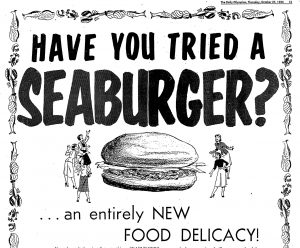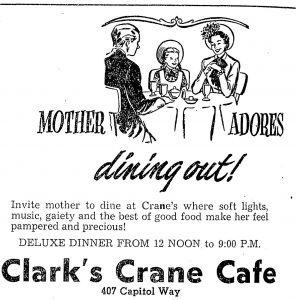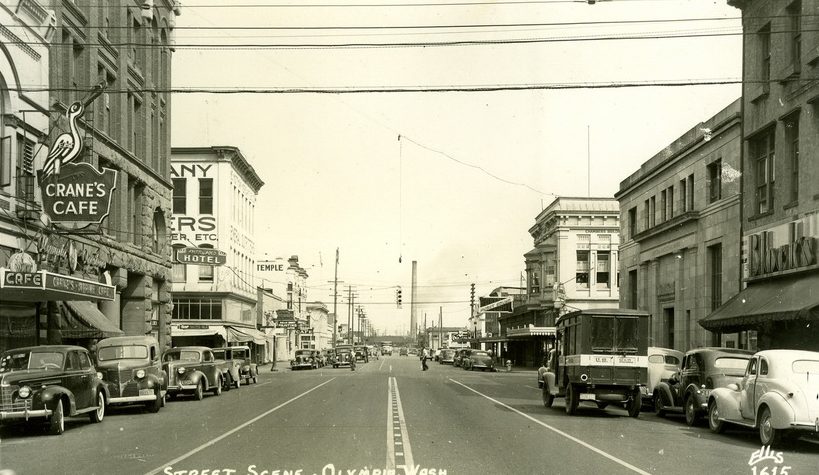In October 1955, Olympia had a new culinary sensation: the Seaburger, a fried patty made of fresh fish, shrimp and meat fried to a golden brown served on a toasted hamburger bun with tartar sauce. Olympians could order this new burger at various locations, but one of the more upscale places was Crane’s Cafe (407 Capitol Way), a landmark business in downtown Olympia for decades.
 Crane’s Cafe was founded in 1916 by Clarence Crane. After engaging in several other business ventures, including delivery and meat markets, in 1915 Crane bought the City Oyster and Chop House on East Fourth Avenue from Harry J. Kline. After a remodel, he reopened the restaurant on March 24 calling it Crane’s Place. Soon Crane decided to relocate his restaurant to the Harris Building at 407 Capitol Way. Crane remodeled this space, adding mahogany fixtures, plate glass mirrors, private booths and a short-order counter. The refurbished restaurant opened for business on June 21, 1917.
Crane’s Cafe was founded in 1916 by Clarence Crane. After engaging in several other business ventures, including delivery and meat markets, in 1915 Crane bought the City Oyster and Chop House on East Fourth Avenue from Harry J. Kline. After a remodel, he reopened the restaurant on March 24 calling it Crane’s Place. Soon Crane decided to relocate his restaurant to the Harris Building at 407 Capitol Way. Crane remodeled this space, adding mahogany fixtures, plate glass mirrors, private booths and a short-order counter. The refurbished restaurant opened for business on June 21, 1917.
Meanwhile, in March 1917 Crane leased a 15-acre farm near the McKinley School. He planned to rent it to a farmer and use the farm’s dairy products, eggs and fresh produce at his restaurant. This would give customers food “from the garden direct to the consumer.”
However, on December 10, 1917, Clarence Crane tragically died when his car ran off a bridge over the Nisqually River. Crane’s Place was temporarily closed, but reopened under the management of Frank A. Lynn who retained the restaurant’s name. He billed it as the “home of the geoduck.”
Ray Klumb, who also owned the Capital City Creamery, bought the restaurant in 1920 and renamed it the Crane Restaurant. He redid the walls in oak and enclosed the kitchen and a private dining room. After Klumb became ill, his sister Lydia and brother-in-law H. R. Derrick operated the restaurant. In about 1921, the name Crane’s Cafe began to be used, but not consistently until later years. In March 1922, Klumb sold the business to Thomas Sawickie of Tacoma, who in turn sold it to William Wilkening in 1924.

Crane’s Cafe flourished under Wilkening’s leadership. The number of employees increased and the cafe was remodeled several times. By 1928, the restaurant had the capacity to serve 200 people. The main dining area had private booths and a long serving counter. Another dining hall and a private club room were available on the mezzanine floor. A bakery was located on a balcony, making pastries for the cafe as well as retail sale. Wilkening even boasted that the restaurant was “known from here to Chicago for its oysters,” serving 2,000 gallons of Olympia oysters in 1927.
Wilkening operated the restaurant with several business partners over time, including Gus Johnson and Gustav R. Krogoll. In 1939, Wilkening added air conditioning and wall murals of colorful fish and mermaids. Six years later, Wilkening retired, selling the restaurant to Johanas “Fred” Fant and Ray Johnston. Fant’s widow Hilda and son Ralph would retain ownership of the building after Fred’s 1947 death until the structure’s demolition. In February 1949, Clark’s Restaurant Enterprises bought the business, renaming it Clark’s Crane Cafe. A restaurant chain, it was the company’s first eatery outside of Seattle. The 1949 Earthquake damaged much of downtown Olympia. The cafe survived the quake, but the Kneeland Hotel next door was torn down.
In 1950, Fran Norton and Arthur Olsen purchased the cafe from Clark’s. The business partners had the kitchen repainted and acquired new stoves and a steam table, working at night so as to keep the place open. In 1956, Harry J. Kaplin and Bill Harris of Tacoma bought the cafe from Olsen. Equal business partners, Kaplin managed the restaurant while Harris handled food purchases. Kaplin and Harris dissolved their partnership in June 1959.

Ed Bemis would be the final owner of the Crane Cafe. He closed the restaurant in 1960 for an extensive remodel. Adding paneled walls, Bemis had the ceiling lowered and booths removed. Private dining rooms were available on the right side of the restaurant, while a dining counter was on the left. In the back of the main room, the kitchen was opened up so diners could watch flame barbecuing. The restaurant reopened in January 1961. Charles Kaplin served as manager.
Customers who dined at Crane’s Cafe’s special Thanksgiving dinner in November 1961 ($2.25 for adults and only $1.00 for children) had no way of knowing that the restaurant’s days were numbered. On the evening of December 22, flames spilled over an overheated grill and started a grease fire. The heavily damaged building was demolished the following year.
A new building at the Capitol Way site would house Yenney Music for several decades before becoming an extension of the Goldberg/Schoenfeld Furniture Building. This extension has been torn down and the area is now a parking lot.
During its height the Crane’s Cafe billed itself as having “everything good to eat” and serving “none but the best” food. Although the restaurant is now gone, it filled the bellies and hearts of both local residents and travelers for many years.




















































